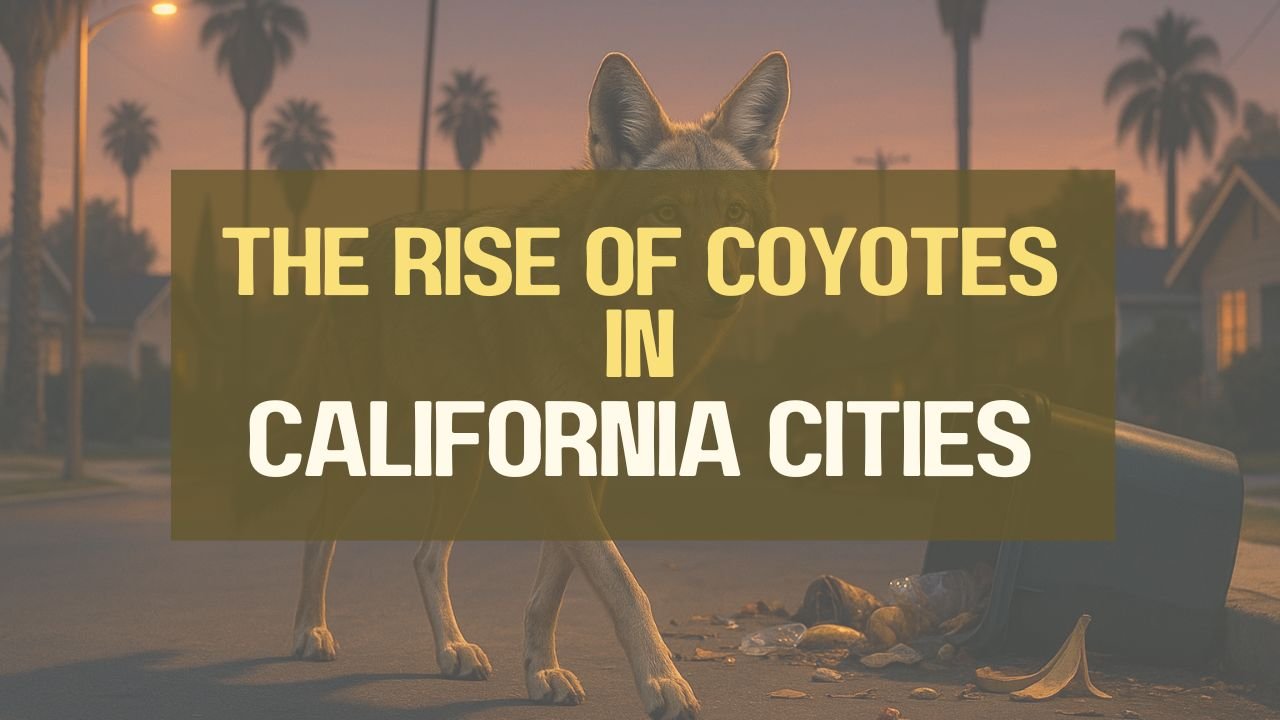If you live in California, chances are you’ve seen a coyote trotting across a quiet street, slipping into a park at dusk, or even wandering near a schoolyard. Once thought of as desert or mountain animals, coyotes have made an extraordinary leap into urban and suburban life.
This sudden rise creates a mix of fascination and fear. People admire their cleverness but worry about their safety, their pets, and the balance between humans and wildlife. The reality is that coyotes are not going away—they are now permanent city residents.
In this comprehensive guide, you’ll learn:
- Why coyotes are appearing more in California cities.
- How they adapt to living alongside people.
- The risks, benefits, and myths about urban coyotes.
- What communities and individuals can do to stay safe.
- The future of human-coyote coexistence in California.
By the end, you’ll have a clear understanding of how to live safely and responsibly with coyotes—without panic and without harm.
The Expansion of Coyotes Across California
Coyotes were once limited mostly to the Great Plains and deserts. But today, they can be found in all 58 counties of California—from downtown Los Angeles to the farmlands of the Central Valley.
Key Drivers Behind the Urban Rise
- Abundant Food Sources
- Trash bins, compost piles, backyard fruit trees, and pet food left outdoors act as irresistible food sources.
- Rodents, rabbits, and feral cats—already plentiful in cities—are natural prey for coyotes.
- Loss of Natural Habitat
- California’s rapid urbanization pushes coyotes from rural areas into suburban spaces.
- Freeways, housing developments, and farmland expansion fragment natural habitats.
- Remarkable Adaptability
- Coyotes eat almost anything: fruits, insects, rodents, carrion, or leftovers from humans.
- They adjust their behavior, hunting patterns, and movement based on their environment.
- Lack of Predators
- Wolves, bears, and mountain lions once regulated coyote numbers.
- In most California cities, these predators are absent, giving coyotes room to thrive.
How Coyotes Survive in California Cities
Unlike many wild animals, coyotes have thrived in human landscapes. Their strategies include:
- Becoming Nocturnal: In heavily populated areas, coyotes mostly roam between 10 p.m. and 5 a.m., avoiding human activity.
- Silent Travel: They use dry riverbeds, storm drains, alleys, and railroad tracks as secret travel corridors.
- Blending In: Coyotes often look like stray dogs from a distance, allowing them to avoid attention.
- Smaller Family Units: Instead of large packs, urban coyotes live in pairs or small family groups, reducing visibility.
Human Encounters: Are Coyotes Dangerous?
Rare but Possible Threats
Coyotes naturally fear humans, but conflicts arise under certain conditions:
- Pet Attacks: Cats and small dogs are the most vulnerable. A coyote can easily jump a fence or snatch an unattended pet.
- Rabies Concerns: While rabies is rare in coyotes, it is a potential risk in any wild carnivore.
- Habituation: When people feed coyotes, intentionally or not, they lose their fear of humans and may act aggressively.
What Science Says
- According to California wildlife agencies, attacks on humans are extremely rare—far fewer than dog bites each year.
- Most reported coyote incidents involve pets, not people.
- Education and prevention play a far bigger role than eradication.
The Benefits of Having Coyotes Around
It may seem surprising, but coyotes actually help balance urban ecosystems:
- Rodent Control: A single coyote can eat thousands of rodents each year. Without them, rat and mouse populations would explode.
- Pest Regulation: By hunting rabbits and gophers, coyotes reduce garden and crop damage.
- Scavenger Role: Coyotes clean up carrion (dead animals), which prevents disease spread.
- Biodiversity Support: Coyotes indirectly keep populations of smaller predators like raccoons and skunks in check, preventing overcompetition.
In short, coyotes act as nature’s cleanup crew and pest managers—even in cities.
Living Safely with Coyotes
Practical Safety Tips for Residents
- For Pet Owners
- Keep cats indoors at night.
- Walk dogs on short leashes, especially near parks or wooded areas.
- Avoid leaving pets outside unsupervised after dark.
- For Homeowners
- Install motion-sensing lights in yards.
- Keep garbage bins sealed with tight lids.
- Pick ripe fruit from trees promptly.
- Eliminate outdoor food sources like pet bowls.
- For Families
- Teach children not to approach or feed coyotes.
- Carry a whistle, air horn, or walking stick on evening walks.
- Report unusually bold coyotes to local animal services.
Hazing: The Best Response
If you see a coyote too close:
- Shout loudly.
- Wave your arms.
- Throw small objects near it (not at it).
- Never run away—stand your ground.
This technique, known as hazing, keeps coyotes wary of humans and reduces conflict.
Key Facts About Coyotes in California Cities
| Factor | Details |
|---|---|
| Typical Weight | 20–40 pounds |
| Lifespan in Wild | 6–10 years |
| Main Food Sources | Rodents, rabbits, fruits, garbage, insects, carrion |
| Peak Activity Times | Nighttime, dawn, dusk |
| Risks | Pet attacks, scavenging trash, potential disease |
| Human Risk | Extremely low; direct attacks on people are very rare |
| Best Response | Hazing, pet supervision, securing trash, avoiding feeding |
| Benefit | Rodent and pest control, biodiversity balance, scavenging role |
Community and Government Action
Local Initiatives
- Public Education Programs: Many California cities host workshops teaching residents how to coexist with coyotes.
- Coyote Watch Programs: Neighborhoods track and share sightings online to raise awareness.
- Hotlines for Reporting: Cities like Los Angeles and Irvine provide hotlines for aggressive coyote behavior.
Government Resources
The U.S. Department of Agriculture (USDA) works with California agencies to manage coyote populations through education, research, and non-lethal solutions.
Visit: USDA – Wildlife Damage Management
Case Studies: Coyotes in California Cities
Los Angeles County
- Reports of coyotes walking through schoolyards and residential neighborhoods have surged.
- The county introduced strict rules against feeding wildlife and launched “Coyote Awareness Month.”
San Francisco Bay Area
- Coyotes have been spotted in Golden Gate Park and even near downtown.
- Researchers fitted coyotes with GPS collars to study their movement across freeways.
Orange County
- Residents formed Coyote Response Teams to share real-time sightings.
- Education reduced unnecessary calls for removal, encouraging safe coexistence.
Myths vs. Facts About Coyotes
| Myth | Fact |
|---|---|
| Coyotes are large, wolf-like animals | Coyotes are smaller, typically 20–40 lbs. |
| Coyotes always travel in big packs | Urban coyotes usually travel alone or in pairs. |
| Coyotes regularly attack humans | Attacks are extremely rare; most incidents involve small pets. |
| Killing coyotes reduces numbers | Removing coyotes often backfires; surviving coyotes breed faster to fill the gap. |
The Future of Coyotes in California
Coyotes are here to stay. Experts predict that their presence will only grow as cities expand and natural landscapes shrink.
Future challenges include:
- Managing Human Fear: Many conflicts stem from fear rather than real danger.
- Better Education: Teaching coexistence from schools to community centers.
- Urban Planning: Designing green spaces and waste systems that reduce coyote reliance on human food.
Instead of seeing coyotes as intruders, Californians may need to view them as wild neighbors sharing the same environment.
Learning to Coexist
Coyotes are no longer just desert wanderers or mountain hunters—they are part of California’s urban wildlife fabric. Their rise in cities reflects both their adaptability and the human impact on landscapes.
By understanding their behavior, securing our homes and pets, and practicing safe coexistence, Californians can reduce conflicts while appreciating the role coyotes play in controlling pests and balancing ecosystems.
The message is simple: coyotes aren’t leaving, so learning to live safely alongside them is the only way forward.
FAQs
How can I keep coyotes out of my yard?
Install secure fencing at least 6 feet tall, add coyote rollers, remove food sources, and keep pets indoors at night.
Do coyotes travel in large packs in cities?
No, urban coyotes usually live in pairs or small family groups. Large packs are more common in rural or wild areas.
What happens if coyotes are removed from a neighborhood?
Studies show that when coyotes are removed, others quickly move in, and surviving coyotes breed more. Coexistence is more effective than removal.



